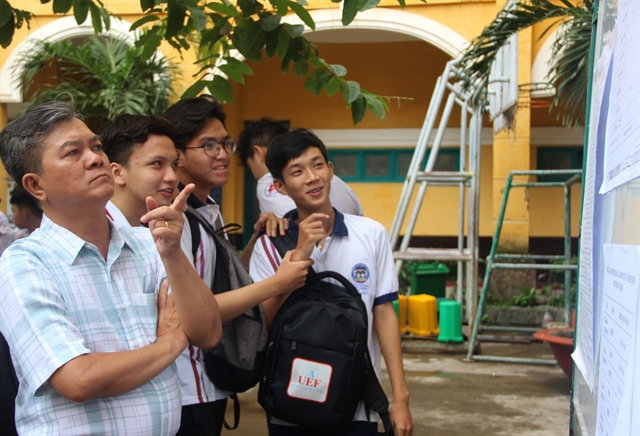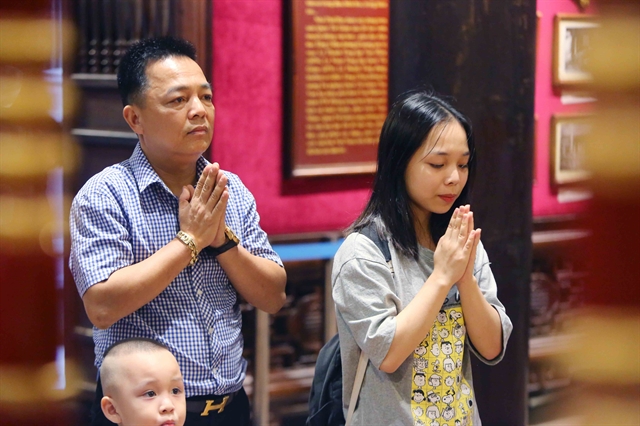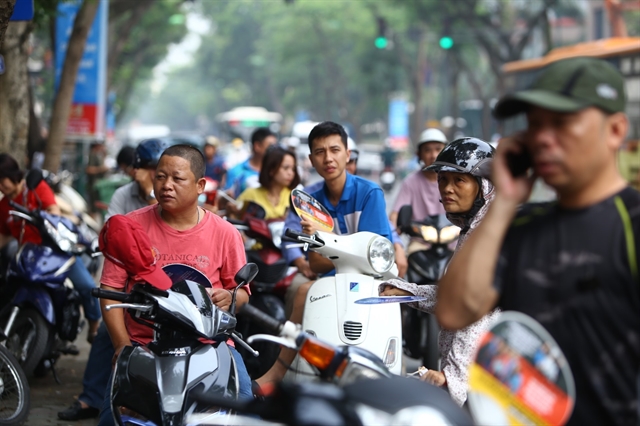 Society
Society

Khoa Thư

|
| Students and parents look at the candidate list at Trưng Vương High School in HCM City’s District 1 during the 2019 national high school examination. — VNA/VNS Xuân Dự |
HÀ NỘI — It took Phương Linh, a twelfth grader at Hà Nội-based Yên Hòa High School, a couple of days to digest the bitter reality before pulling herself together and preparing for the coming graduation examination in August.
Final-year students and their parents experienced three weeks of turbulence stirred up by constant changes of the national high school examination just before returning to school after a lengthy closure due to the COVID-19 pandemic.
Considered a major event in Việt Nam, the annual national high school examination is attended by some 900,000 candidates – both twelfth graders and non-students – in seek of slots at domestic higher education institutes. With the power invested in it, the exam is believed to decide whether one will make it in life.
In 13 years, from 2001 to 2014, final-year students had to consecutively take two intense examinations each year – the high school graduation examination in June and the national university entrance examination in July, which took place on the same dates, used the same tests and results to process students’ applications for all universities nationwide, also known as “three commons”.
The university entrance examination back then was a fierce competition in the scorching summer between candidates and complicated tests which required days and nights of preparation as well as the 12-year-long efforts and hope of thousands of families wrapped up in two days.
A ground-breaking change was made in 2015 with the introduction of the “two-in-one” national high school examination, annually scheduled in June, which has its results used to decide whether candidates are qualified for high school graduation and determine admissions to universities and colleges.
The adjustment was expected to ease the mental and financial pressure on candidates and their families. Instead of taking two separate exams, they only need to sit for one. Instead of going to appointed venues, mostly in big cities where the schools are located, they can stay in their localities.

|
| A student and her father pray at Hà Nội’s Temple of Literature which hosts the Imperial Academy – Việt Nam’s first university, ahead of the 2019 national high school examination. — VNA/VNS Photo Thành Đạt |
This year, the seminal examination was announced to be held in early August following the disease-caused interruption. The delay, however, is only the first upheaval candidates have to face on the path to their dream schools.
“It felt like riding a roller-coaster,” Linh recalled about the moment she learned of exam plans by the Ministry of Education and Training (MoET) on April 14, when Hà Nội was still under strict social distancing measures.
At the time, the ministry expected to conduct the national high school examination from August 8 to 11 if the pandemic is brought under control. Otherwise, the exam would be cancelled and localities would take responsibility to decide criteria of high school graduation.
On April 21, final-year students were shocked when MoET planned to replace the national high school examination with the high school graduation exam, with the sole purpose of recognising students who finish the high school’s education programme. Candidates would have to do four tests on Mathematics, Literature, foreign languages and social sciences (history, geography and civic education) or natural sciences (biology, physics and chemistry). Each combination of three subjects would receive one mark. The proposal was approved by Prime Minister Nguyễn Xuân Phúc the following day, triggering students’ uproar as it meant they would have to learn up to six subjects instead of focusing on three – which would have be used to process their enrollment – as planned.
Many non-student candidates witnessed their future disappearing without knowing whether they would be qualified for the examination. Some of them even got desperate and planned to give up.
Even universities got confused and switched between admissions methods. While HCM City University of Education and Technology preferred scanning students’ high school transcripts over using the test scores, Việt Nam National University – Hà Nội (VNU – Hà Nội) announced to hold their own competency assessment exam.
“It was definitely a heart-dropping, U-turn from MOET,” said Linh. “Many of us know that giving one mark for a combination of three different subjects will cause difficulties for universities and colleges to set minimum entry scores.”
“The pandemic has taken away many days of our final year but even the exam preparation has not been done as we wanted it to be. I was confused and helpless,” she added.
On April 27, after a meeting with Deputy PM Vũ Đức Đam, Minister of Education Phùng Xuân Nhạ decided to keep three marks for three subjects of each combination. The purpose of this year’s exam, however, was kept unchanged.
VNU – Hà Nội on May 4 withdrew the plan on a competency assessment exam and decided to use the 2020 high school graduation results, international standardised tests of SAT, A-level, IELTS and other secondary criteria to enroll students.
Hà Nội’s prestigious Foreign Trade University, which Linh intends to apply for, also opted for a combination of admission methods after the independent assessment exam which they planned to co-host with VNU – Hà Nội was cancelled.
“At that time, the Law on Education and the Law on Higher Education came into effect for a month. The two laws allow universities to enroll the students by themselves instead of using high school examination results for university admissions as before,” explained Deputy Minister Nguyễn Hữu Độ.
However, teachers questioned the ministry’s decisions and failure to ensure consistency in compiling examining policies.
“These changes are unreasonable and unfair for the class of 2020 when they were made four months prior to the actual exam and right before students came back to campus after a prolonged school closure,” said Văn Trung, a mathematics teacher of Thái Phiên High School in central Quảng Nam Province’s Hà Lam Town.
“Insecurity and uncertainty are common amid the COVID-19, especially for final-year students who are studying for their deciding examination,” he added.

|
| Parents wait for their children as they sit for the 2019 national high school examination at Hà Nội’s Việt Nam – Germany High School. — VNA/VNS Photo Minh Quyết |
A doomed generation
“They are a doomed generation,” exclaimed Phương Thúy in central Quảng Trị’s Cam Lộ District whose son will apply for HCM City University of Architecture and Văn Lang University.
“Both their most important life events have happened in times of pandemics,” she said, adding: “When they were born, SARS were sweeping over Asia. Now, their education is being interrupted by COVID-19.”
“In this time of darkness, MoET’s indecisiveness and inconsistency push students and their families deeper into despair,” she said, adding that this year’s exam might be the most unfair to ever happen.
“Online studying sounds easy for students in cities but not those living in rural areas,” Thúy said.
Only 15 of some 40 classmates of her son had access to lessons on the conference hosting platform Zoom.
In Đắkrông – a mountainous district of Quảng Trị, Hồ Thị Sương and Hồ Thị Tăm, two twelfth graders of Đắkrông High School, had to set up a tent on a high hill near their village to catch a 3G signal.
From Monday to Friday, they carried a backpack full of books and climbed up the hill to study inside that makeshift classroom.
“It was a nightmare for us to use up free 3G,” said Sương.
Lê Chí Thông, principal of Đắkrông High School, said only 65 per cent of their 225 final-year students have smartphones and 3G SIMs. However, many of them could not access online classrooms as the mobile signal in their villages was too weak.
MoET said they would streamline the grade 12’s second semester programme out of the 2020 examination.
On Thursday, a set of official illustrative tests were released by the ministry with lower levels of difficulty compared to previous years’.
“For this year’s illustrative English test, only 10 per cent of questions require high ability of using English, mostly in the reading part while the level accounted for about 20 per cent of last year’s test,” said Võ Văn Linh, a teacher of Nguyễn Thái Bình High School in Quảng Nam Province.
Anh Khôi, a twelfth grader of HCM City’s Gò Vấp High School, said after all those ups and downs, it is the time to ramp up studying for the exam.
“My classmates and I are trying our best to cover the second semester programme as soon as possible and work on previous years’ tests although MoET’s decisions shocked us and placed heavy burdens on us,” he said.
Thúy’s family could finally breathe a sigh of relief when HCM City University of Architecture announced that they would not host an independent assessment examination.
“My son will only need to take a drawing test in HCM City as well as have his transcripts and high school examination results screened for admission,” Thúy said.
“At least, we do not need to travel back and forth between Quảng Trị and HCM City for universities’ own examinations,” she added.
“The fight, however, has just begun.” — VNS




